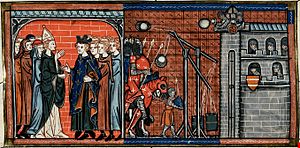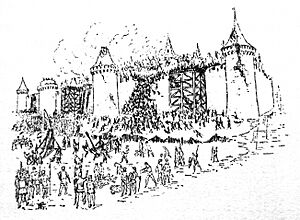Siege of La Rochelle (1224) facts for kids
Quick facts for kids Siege of La Rochelle, 1224 |
|||||||||
|---|---|---|---|---|---|---|---|---|---|
| Part of the Capetian–Angevin feuds | |||||||||
 Detail of a medieval miniature of the siege of La Rochelle. |
|||||||||
|
|||||||||
| Belligerents | |||||||||
| Commanders and leaders | |||||||||
Geoffrey de Neuville |
|||||||||
The Siege of La Rochelle in 1224 was a very important battle. It decided who would control the region of Poitou in France: the Capetian kings of France or the Plantagenet kings of England. French forces, led by King Louis VIII, surrounded the port city of La Rochelle. This city was defended by soldiers from Poitou and England, led by Savari de Mauléon.
La Rochelle was a key place for the English Plantagenet kings. They used it to try and get back lands in France that they had lost since 1203. The siege lasted from July to August 1224. In the end, the people of La Rochelle gave up the city to King Louis. This happened because the English army did not arrive to help them. The siege of La Rochelle was a big win for France. It meant that Poitou was now fully under French control. After this, only Gascony in France remained under English rule.
Contents
Why the Siege Happened
La Rochelle and English Rule
The city of La Rochelle became part of English lands in 1152. This happened when Eleanor of Aquitaine married Henry Plantagenet. Henry was the duke of Anjou and Normandy. Two years later, he became king of England as Henry II. His lands, sometimes called the Angevin Empire, included much of western France, England, and parts of Ireland. These lands were passed down to his sons, Richard I and John.
King John gave special benefits to La Rochelle in 1202, 1204, and 1207. For example, the city did not have to pay certain taxes. It also did not have to send soldiers for some military duties. Plus, it could collect taxes from anyone entering or leaving the city.
Conflict Between Kings
The French Capetian kings and the English Plantagenet kings often fought. This conflict grew after 1203. That year, Philip II of France said King John had lost his French lands. This was because John had married Isabella of Angoulême without permission.
France then took control of Normandy, Anjou, and parts of Aquitaine. Philip II won a major battle at Bouvines in 1214. Later, Prince Louis (who would become Louis VIII) invaded England in 1216–1217.
By 1224, King John's son, Henry III, was king of England. He was busy fighting a war at home, like the Siege of Bedford in 1224. Henry III also did not have much money. This made it hard for him to stop a French attack on his remaining strongholds in northern Aquitaine.
The Fight for La Rochelle
French Army Marches South
Just four days after the Siege of Bedford ended, King Louis VIII gathered his army. They met at Tours and then moved to Montreuil-Bellay. A writer named Nicholas of Bray said the French army included soldiers from Brittany, Normandy, Flanders, and Champagne.
On June 24, 1224, Duke Peter I of Brittany gave a powerful speech to the army in Tours. After this, they marched south. King Louis quickly took over smaller towns in Poitou. He captured Niort on July 5. This happened after a two-day fight with a group of soldiers led by Savari de Mauléon. Savari's soldiers managed to escape and went to La Rochelle.
After taking Saint-Jean-d'Angély, Louis finally began the siege of La Rochelle on July 15.
Defending La Rochelle
Savari de Mauléon was in charge of defending La Rochelle. His forces were made stronger by English troops. These English soldiers, led by Geoffrey de Neuville, had arrived in June.
The City Surrenders
The exact way the siege ended is not fully clear. However, a record from St. Martin of Tours says the city surrendered on August 3. French soldiers entered La Rochelle soon after. But the citizens of the city did not officially promise loyalty to Louis until August 13.
A writer named Ralph of Coggeshall said the citizens agreed to surrender with certain conditions. They seemed to realize that England would not send much help. This was because England was still dealing with problems after the Bedford siege. The citizens had planned to surrender if English help did not arrive by Christmas. But with French troops already in the city, they gave up sooner.
Geoffrey's English soldiers did not take part in the surrender. King Louis allowed them to leave peacefully with their weapons. However, Savari de Mauléon's reputation among the English was damaged. People accused him of being a traitor. His attempts to explain why La Rochelle fell to King Henry III failed. By Christmas 1224, Savari joined King Louis's service. Historian David Carpenter believes La Rochelle fell because its citizens "had simply lost the will to fight for the Angevin cause."
What Happened Next
New Rules for La Rochelle
After the siege in 1224, King Louis VIII promised to keep all the special benefits for La Rochelle. He encouraged trade by making sure goods going to or from the city were safe. Normal taxes still applied, though. If France went to war with a country where a trader was from, that trader's goods were safe for 20 days. During this time, the trader could leave the city with their goods unharmed.
Changes in Trade
La Rochelle becoming part of the French king's lands changed its trade. The city had strong trade ties with England and Ireland, especially in selling wine. La Rochelle wine had been sold in England since the late 1100s. Many English and Irish traders had lived in the city.
To make up for this loss, La Rochelle increased its trade with northern countries like Flanders. Until Bordeaux became the main port for wine, La Rochelle was the top wine exporter on the Atlantic coast in the 1200s and 1300s. In return for wine, the city imported cereals and cloth from Flanders. It also imported tin from Cornwall and lead from Ireland.


